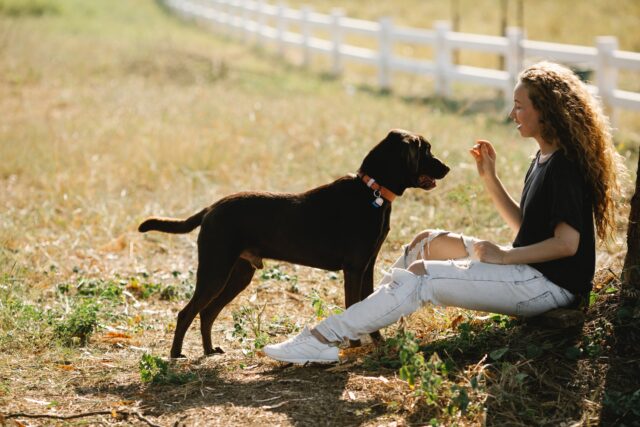Positive reinforcement and proper balanced dog training go hand-in-hand. You can’t have one without the other.
Nevertheless, the two are sometimes misrepresented as mutually exclusive. We want to help clear that up.
We’ve answered the most common questions dog owners ask about positive reinforcement to help you understand its role in balanced dog training.
What is positive reinforcement dog training?
Positive reinforcement is one of the four quadrants of operant conditioning. In dog training, positive reinforcement is a technique used to encourage a desired behavior. It involves adding a favorable stimulus to a training session to increase the likelihood of the desired behavior being repeated in the future.
Simply put, positive reinforcement is giving your dog incentive to continue with good behavior.
Does positive reinforcement work in dog training?
Yes. Positive reinforcement is an effective tool for dog trainers to use when modifying behavior. It’s an essential part of training every dog. However, positive reinforcement is just one piece of the balanced dog training puzzle.
Positive reinforcement is meant to be used in conjunction with the other three quadrants of operant conditioning. Together, the four quadrants can be utilized throughout training in a variety of different ways to achieve the best results. How the quadrants are used depends on the individual dog, their behaviors and environment, and the owner’s training goals.
What are the four quadrants of dog training?
The four quadrants of dog training are: positive reinforcement, negative reinforcement, positive punishment and negative punishment.
These quadrants make up the four different types of operant conditioning. They’re used to teach a dog which behaviors are desired and which are not based on rewards or consequences.
Every dog learns differently. The four quadrants help trainers understand a dog’s learning process and how to teach them effectively. Experienced balanced dog trainers can adapt the four quadrants to find the most effective combination for any dog.
The four quadrants of dog training are often misunderstood. For example, “negative” doesn’t mean “bad”; it means “to subtract.” Meanwhile, “punishment” doesn’t mean to harm or use force; it means to decrease the likelihood of a behavior happening again.
So, “negative punishment” means to subtract something from a training session to get less of a behavior. For example, withholding a treat if your dog doesn’t want to sit.
Reading our in-depth article will help you learn more about the four dog training quadrants. The article includes full scientific definitions and examples for each quadrant. It also provides advice on how you and your canine companion can benefit from these quadrants.
Can I only train my dog with positive reinforcement?
On its own, positive reinforcement isn’t enough to effectively train your dog. Positive reinforcement is intended to be used with the other operant conditioning quadrants to modify behavior.
That’s why there is no such thing as positive-only dog training. The term “positive-only” ignores the scientific definitions of what “positive,” “negative,” “reinforcement” and “punishment” mean in the context of the four quadrants of operant training.
Many dog trainers who advertise themselves as positive-only use negative and positive punishment. This includes withholding rewards to reduce a behavior and using training tools, such as head halters, to decrease unwanted behavior.
How long does positive reinforcement training last in dogs?
Like everything in dog training, it depends.
It’s never as simple as teaching a dog what to do and what not to do over the span of a few weeks without any further instruction.
Training is a continuous, life-long process. It doesn’t end when your dog comes home from a board and train or when you finish with your in-home training sessions. That’s just the beginning.
Owners play a vital part in keeping training consistent. This helps ensure the dog understands what behavior is expected, and strengthens the bond between dog and owner.
At Koru K9, we put an emphasis on the relationships between the dogs we work with and their owners. We train both the dog and the owner so that communication is always clear. We assign homework for our in-home sessions and offer hands-on follow-up sessions after our board and train programs.
Balanced Dog Training vs. Positive Reinforcement
Every dog is unique in their breed, temperament, drives, past experiences, living situation, and so on. So, a one-size-fits-all approach to dog training won’t work for every dog.
Proper balanced dog trainers, like those at Koru K9, focus on working with the dog who’s in front of them. Balanced trainers take every aspect of a dog’s life into consideration. They use the four quadrants of operant conditioning, as well as other training methods and training tools, to create a unique plan based on the dog’s needs.
So, what is the difference between balanced dog training and positive reinforcement dog training?
As we’ve detailed throughout this article, positive reinforcement is an important part of balanced dog training. But it’s just that: one part of a bigger picture. Balanced dog training looks at that entire picture to achieve the best possible results for every dog.
Koru K9’s balanced trainers don’t rely on one particular approach, like positive reinforcement. Instead, we adapt our approach to each individual dog.

